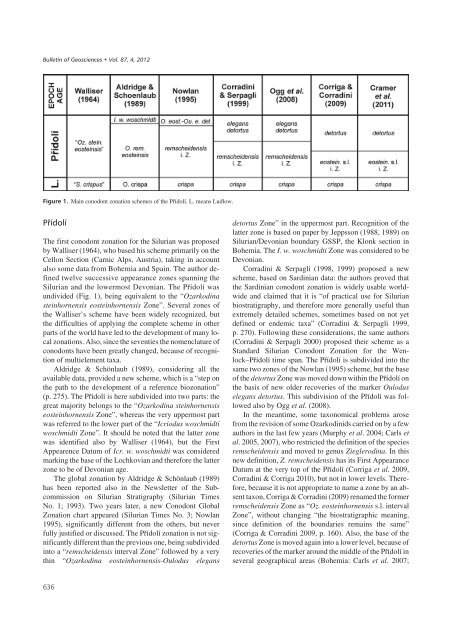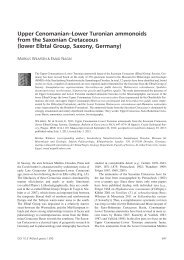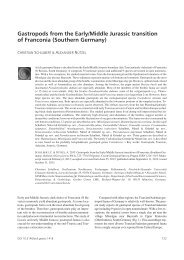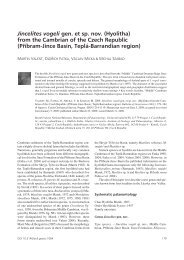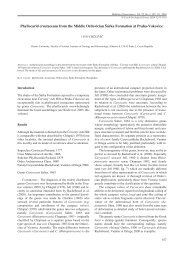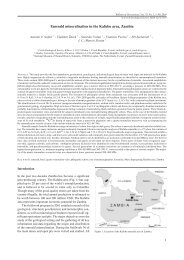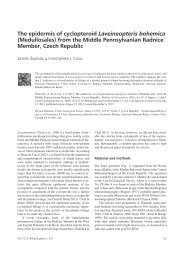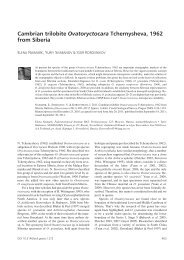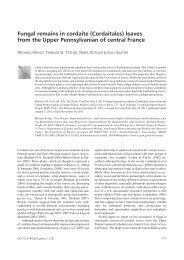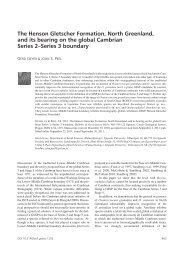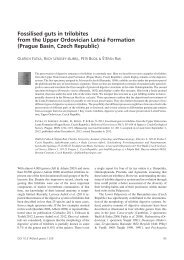full text (PDF, 1.71 MB)
full text (PDF, 1.71 MB)
full text (PDF, 1.71 MB)
Create successful ePaper yourself
Turn your PDF publications into a flip-book with our unique Google optimized e-Paper software.
Main conodont zonation schemes of the Přídolí. L. means Ludlow.<br />
<br />
The first conodont zonation for the Silurian was proposed<br />
by Walliser (1964), who based his scheme primarily on the<br />
Cellon Section (Carnic Alps, Austria), taking in account<br />
also some data from Bohemia and Spain. The author defined<br />
twelve successive appearance zones spanning the<br />
Silurian and the lowermost Devonian. The Přídolí was<br />
undivided (Fig. 1), being equivalent to the “Ozarkodina<br />
steinhornensis eosteinhornensis Zone”. Several zones of<br />
the Walliser’s scheme have been widely recognized, but<br />
the difficulties of applying the complete scheme in other<br />
parts of the world have led to the development of many local<br />
zonations. Also, since the seventies the nomenclature of<br />
conodonts have been greatly changed, because of recognition<br />
of multielement taxa.<br />
Aldridge & Schönlaub (1989), considering all the<br />
available data, provided a new scheme, which is a “step on<br />
the path to the development of a reference biozonation”<br />
(p. 275). The Přídolí is here subdivided into two parts: the<br />
great majority belongs to the “Ozarkodina steinhornensis<br />
eosteinhornensis Zone”, whereas the very uppermost part<br />
was referred to the lower part of the “Icriodus woschmidti<br />
woschmidti Zone”. It should be noted that the latter zone<br />
was identified also by Walliser (1964), but the First<br />
Appearence Datum of Icr. w. woschmidti was considered<br />
marking the base of the Lochkovian and therefore the latter<br />
zone to be of Devonian age.<br />
The global zonation by Aldridge & Schönlaub (1989)<br />
has been reported also in the Newsletter of the Subcommission<br />
on Silurian Stratigraphy (Silurian Times<br />
No. 1; 1993). Two years later, a new Conodont Global<br />
Zonation chart appeared (Silurian Times No. 3; Nowlan<br />
1995), significantly different from the others, but never<br />
<strong>full</strong>y justified or discussed. The Přídolí zonation is not significantly<br />
different than the previous one, being subdivided<br />
into a “remscheidensis interval Zone” followed by a very<br />
thin “Ozarkodina eosteinhornensis-Oulodus elegans<br />
detortus Zone” in the uppermost part. Recognition of the<br />
latter zone is based on paper by Jeppsson (1988, 1989) on<br />
Silurian/Devonian boundary GSSP, the Klonk section in<br />
Bohemia. The I. w. woschmidti Zone was considered to be<br />
Devonian.<br />
Corradini & Serpagli (1998, 1999) proposed a new<br />
scheme, based on Sardinian data: the authors proved that<br />
the Sardinian conodont zonation is widely usable worldwide<br />
and claimed that it is “of practical use for Silurian<br />
biostratigraphy, and therefore more generally useful than<br />
extremely detailed schemes, sometimes based on not yet<br />
defined or endemic taxa” (Corradini & Serpagli 1999,<br />
p. 270). Following these considerations, the same authors<br />
(Corradini & Serpagli 2000) proposed their scheme as a<br />
Standard Silurian Conodont Zonation for the Wenlock–Přídolí<br />
time span. The Přídolí is subdivided into the<br />
same two zones of the Nowlan (1995) scheme, but the base<br />
of the detortus Zone was moved down within the Přídolí on<br />
the basis of new older recoveries of the marker Oulodus<br />
elegans detortus. This subdivision of the Přídolí was followed<br />
also by Ogg et al. (2008).<br />
In the meantime, some taxonomical problems arose<br />
from the revision of some Ozarkodinids carried on by a few<br />
authors in the last few years (Murphy et al. 2004; Carls et<br />
al. 2005, 2007), who restricted the definition of the species<br />
remscheidensis and moved to genus Zieglerodina. In this<br />
new definition, Z. remscheidensis has its First Appearance<br />
Datum at the very top of the Přídolí (Corriga et al. 2009,<br />
Corradini & Corriga 2010), but not in lower levels. Therefore,<br />
because it is not appropriate to name a zone by an absent<br />
taxon, Corriga & Corradini (2009) renamed the former<br />
remscheidensis Zone as “Oz. eosteinhornensis s.l. interval<br />
Zone”, without changing “the biostratigraphic meaning,<br />
since definition of the boundaries remains the same”<br />
(Corriga & Corradini 2009, p. 160). Also, the base of the<br />
detortus Zone is moved again into a lower level, because of<br />
recoveries of the marker around the middle of the Přídolí in<br />
several geographical areas (Bohemia: Carls et al. 2007;


